Optical / Active Optical Cable (OC / AOC)
Signal transmission through light impulses
Content
What are optical cables?
Optical cables, if active or passive, transfer data through light. In general, optical cable / AOC accepts the same electric inputs and outputs as the older copper cables. Indeed, they have optical fibers which "connect" the plugs. Optical fiber conductors can forward optical signals. The optical cables are equipped with transceivers that convert the electrical into optical signals. Basically, you can differ between active and passive optical cables.
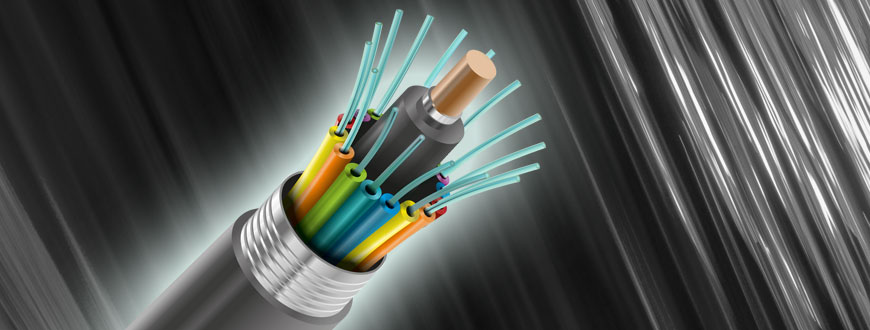
Active optical cables (AOC) and passive optical cables
With active optical cables, the signal converter is located in the plug connector of the cable. For the optic transfer of the signals, there is no need for an additional power supply unit because the signal converter gets its current from the bus.
With passive optical cables, the signal converter is outside the cable. The actual cable has in its inner only the optical fibers for the optic signal transfer, and the connection elements at its ends, of course.
For what reasons AOC and optical cables?
Optic cable connections displace the old copper connections more and more, for comprehensible reasons. With the progress of mobile technology or cellular standards, also the requirements for data transfer rates and bandwidth raise. Data connections from copper no longer provide sufficient capacities, especially in regard to overcoming larger distances and connecting places that are far apart.
In contrast, optical fiber conductors, or the optical fiber technology in the inner of optical fiber cables, offer completely new possibilities in this area and cover the new need. Because, the optical cable has, compared to the copper cable, a wide range of advantages in regard to data amounts and transmission distances. Learn more about it in the following.
Advantages and specifications of optical cables
With the optical transfer, the signal shape is much better preserved than with the transmission via copper. A better-preserved signal shape means a much lower signal attenuation again. As a result, optical cables can transfer a very high amount of data over much longer distances.
As for the physical structure and material, optical conductors are lighter and have a smaller cross-section than copper conductors. At the network installation in large data centers, for example, the advantage of the lighter material should not be underestimated. Additionally, optical cables are more flexible than copper cables.

Besides the highly precise signal transmission, a further advantage of optical conductors is their very good electromagnetic compatibility (EMC). No disturbance by capacitive or inductive fields can occur because, by the optical cables, no current is transferred.
As a result of the advantages described, connections with AOC are now not only found in the network sector but also in other fields of application such as AV and multimedia. A practical example is razor-sharp 4K playback at 120 hertz and over 30 or more meters, completely lossless.
(* Photo by Tyler Mohrman on Unsplash)
Active optical cables from Delock
Our active optical cables are designed for the transmission of HDMI or DisplayPort signals with a resolution of up to 8K or USB or Ethernet signals with a data rate of up to 10 Gbps. The most active optical cables for video are uni-directional, and transfer signals up to 100 m.
Depending on the application, additional copper lines may be required, e.g. for the power supply in USB or HDMI cables; then we speak of hybrid cables. In this case, "hybrid" means that one part of the wires is optical and the other is electrical, or: you have both fiber optic and copper wires.
AOC product examples from Delock
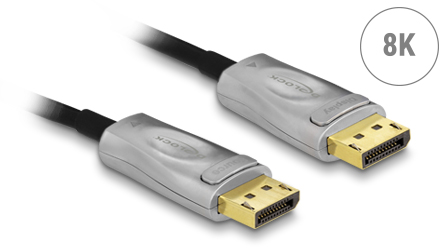
Item 85885
Active Optical Kabel DisplayPort 1.4 8K | 10 m
- 2 x DisplayPort 1.4 male (downwards compatible)
- Data rate up to 32.4 Gbps
- Fixed signal direction
- Also in 15, 20, 25, 30, 50, 70 and 100 m
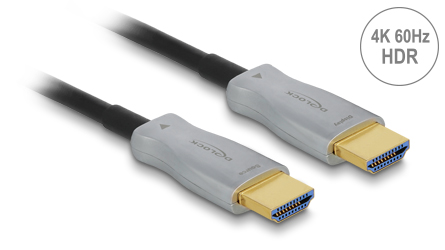
Item 85010
Active Optical Cable HDMI 4K 60 Hz | 10 m
- 2 x HDMI-A male
- Data rate up to 18 Gbps
- Fixed signal direction
- Also in 15, 20, 25, 30, 50, 70 and 100 m
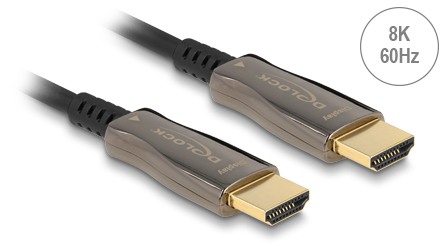
Item 84034
Active Optical Cable HDMI 8K | 10 m
- 2 x HDMI-A male
- Data rate up to 48 Gbps
- Fixed signal direction
- Also in 15, 20, 25 and 30 m
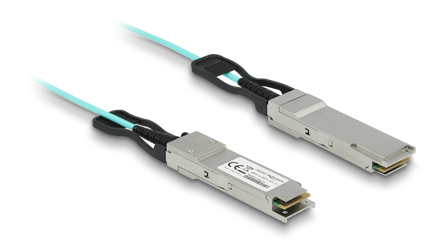
Item 84042
Active Optical Cable QSFP+ | 3 m
- 2 x QSFP+ male
- 40 Gigabit Ethernet up to 40 Gbps
- Compatible to QSFP MSA, SFF-8436
- Also in 5 and 10 m
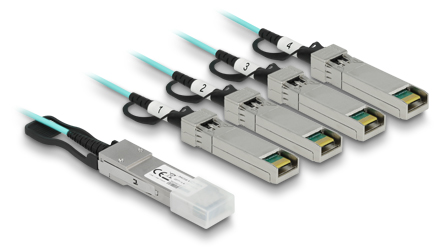
Item 84058
Active Optical Cable QSFP+ to 4 x SFP+ | 3 m
- 1 x QSFP+ male to 4 x SFP+ male
- 40 Gigabit Ethernet up to 40 Gbps
- Compatible to QSFP MSA, SFF-8436
- Also in 5 and 10 m
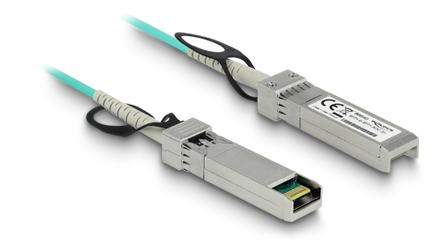
Item 86640
Active Optical Cable SFP+ | 3 m
- 2 x SFP+ male
- 10 Gigabit Ethernet up to 10 Gbps
- Compatible to SFP+ MSA, SFF-8431, SFF-8432
- Also in 5, 7 and 10 m
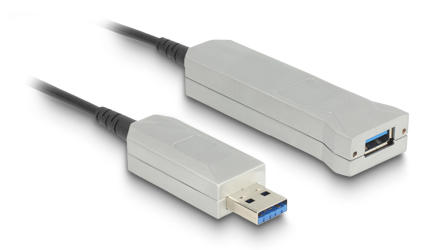
Item 83739
Active Optical Cable USB 5 Gbps| 20 m
- 1 x USB 5 Gbps Type-A male to Type-A female
- 1 x USB Type Micro-B female (5 V power supply)
- Data rate up to 5 Gbps
- Also in 50 m
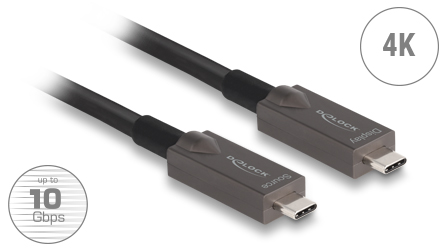
Item 84144
Active Optical USB-C™ Video + Data + PD Cable | 3 m
- 2 x 10 Gbps USB Type-C™ male
- Data rate up to 10 Gbps
- Hybrid cable
- Also in 5, 8 and 10 m
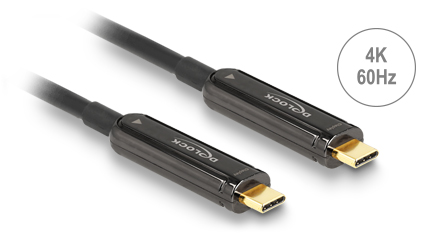
Item 84103
Active Optical USB-C™ Video Cable 4K 60 Hz | 10 m
- 2 x USB Type-C™ male
- Data rate DisplayPort 1.2 up to 21.6 Gbps
- Resolution up to 3840 x 2160 @ 60 Hz
- Also in 15, 20, 25 and 30 m
